Abstract
The relationships between some parameters of cholesterol metabolism and body weight were studied in 22 subjects. Cholesterol-4-14C, complexed with plasma lipoprotein, was injected intravenously and from the resultant specific activity-time curves a number of indexes of cholesterol turnover were calculated. These were based on the two-pool model previously described by Goodman and Noble and included estimates of the sizes of the two pools, the production rate of cholesterol in the system, the rate constants for cholesterol removal from the two pools and transfer between the pools, and the metabolic clearance of cholesterol.
Single and multiple regression analysis was used to define the relationships between the turnover and distribution of cholesterol and the total weight and fat content of the body.
The amount of cholesterol in the more rapidly turning over pool A, which probably includes cholesterol in liver, plasma, erythrocytes, and part of the viscera such as intestine, varied from 14.9 to 32.7 g. The mean value for the extraplasma part of pool A was 17.9 g. Making certain assumptions it was possible to derive estimates of the probable lower and upper values for size of pool B (exchangeable cholesterol in tissues other than in pool A), which were, on average, 35 and 60 g. The daily production rate of cholesterol (assumed to be equivalent to total turnover rate) varied between 0.73 and 1.68 g/day.
The production rate of cholesterol and the size of pool B were significantly related to total body, and particularly to excess body, weight. When the plasma content was excluded, the amount of cholesterol in pool A was not related to weight. For a body of ideal weight the production rate was 1.10 g/day and the size of pool B between 32 and 53 g. For each kilogram of excess weight the expected increments were 0.0220 g/day and 0.90 g, respectively.
The plasma cholesterol concentration was not related to the production rate or to the amount of cholesterol in the two pools. It was, however, inversely related to the fractional rate of removal from pool A and to the metabolic clearance rate of cholesterol which suggests that inadequate excretion could be of importance in the development of hypercholesterolemia.
Full text
PDF
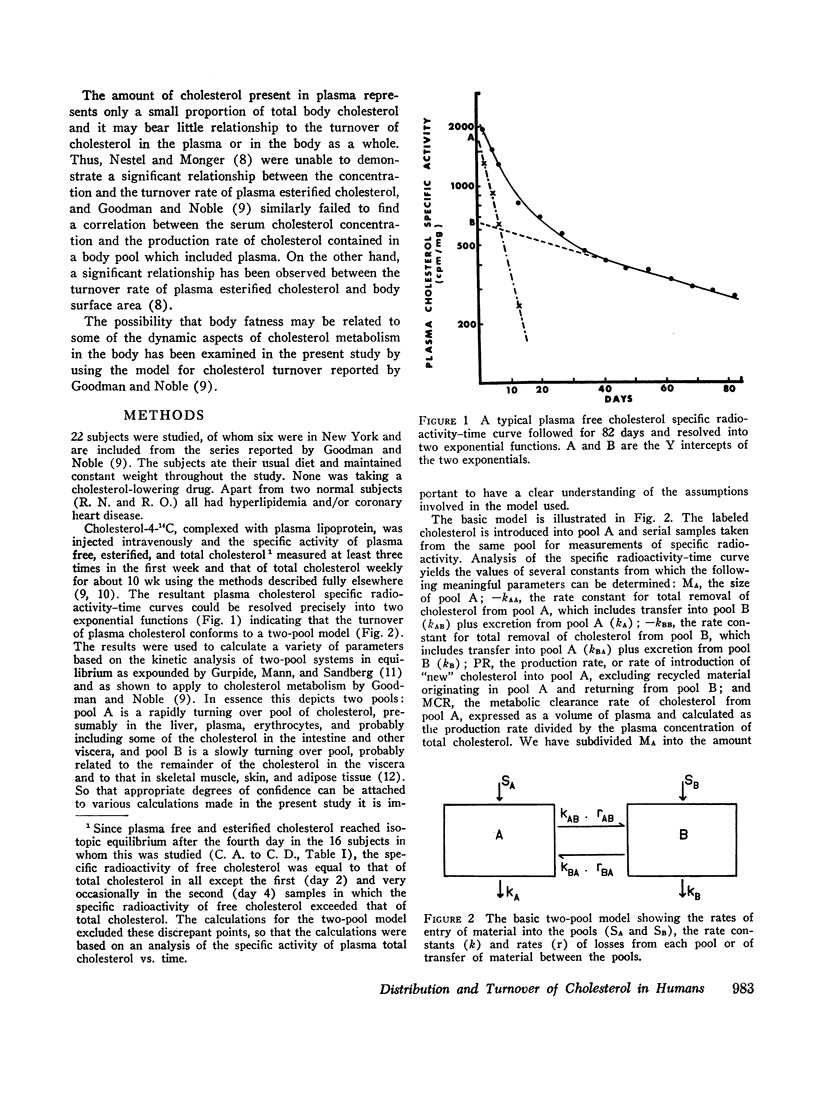
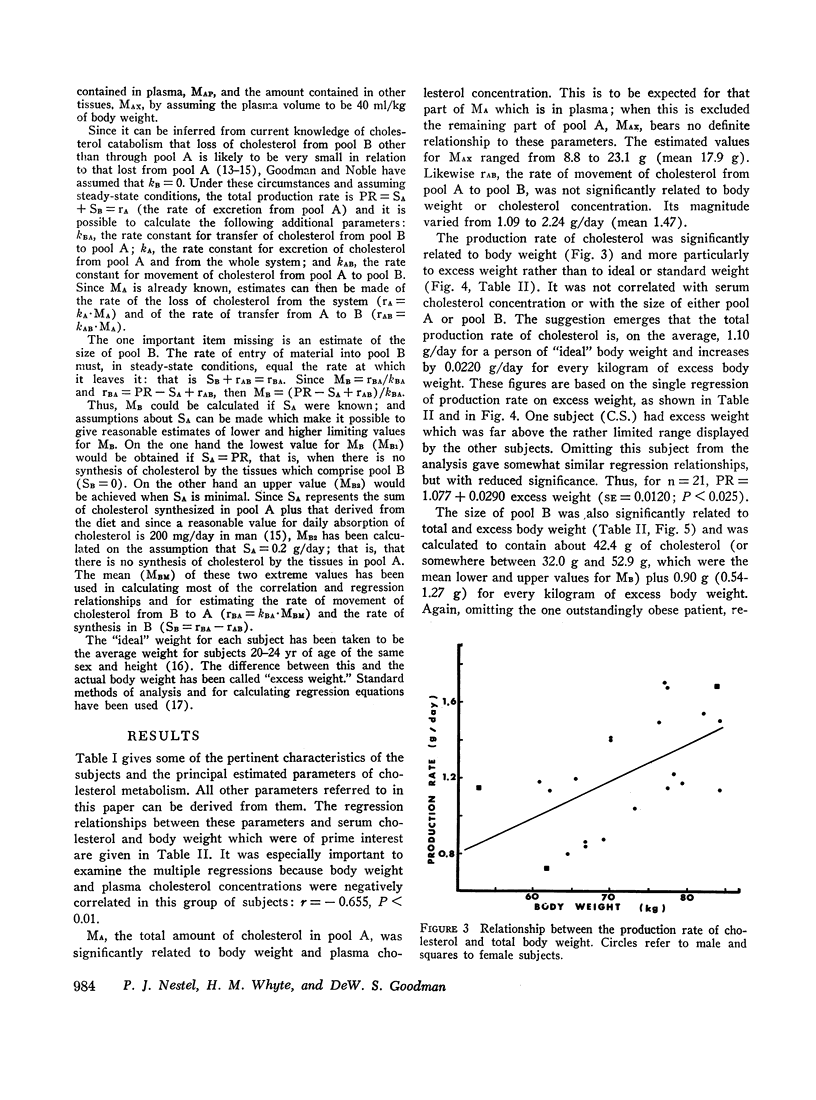
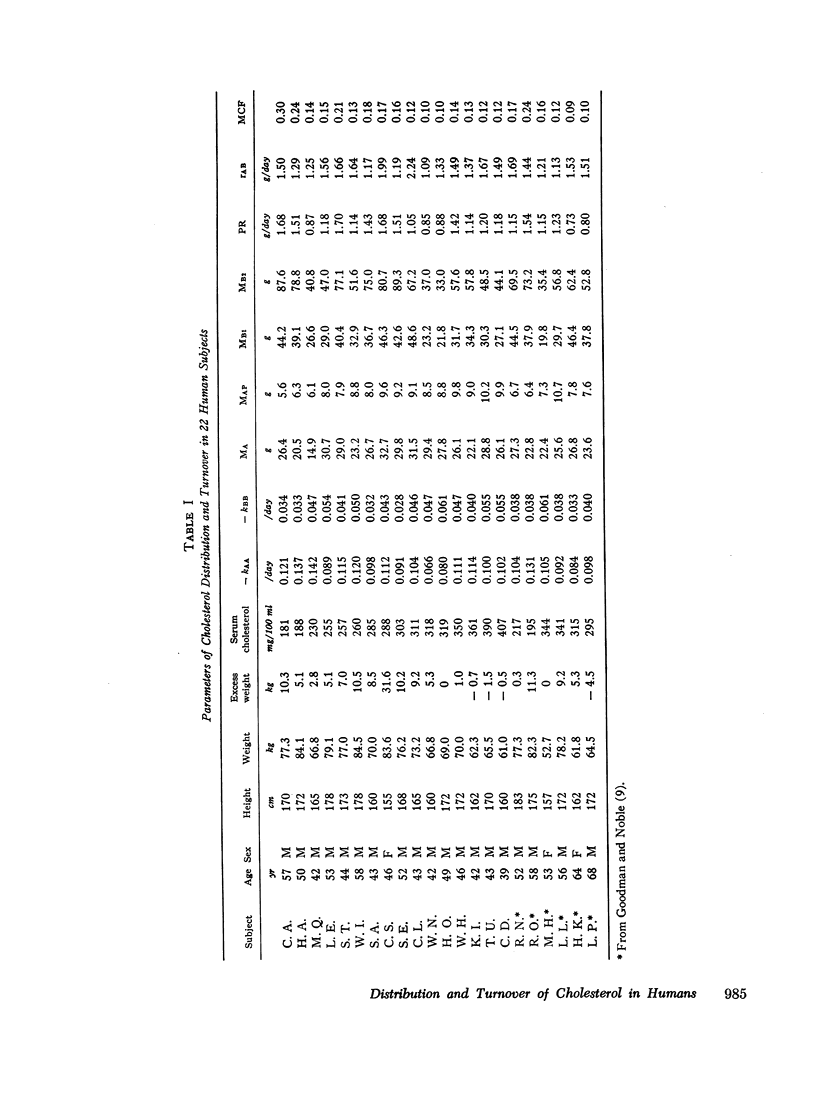
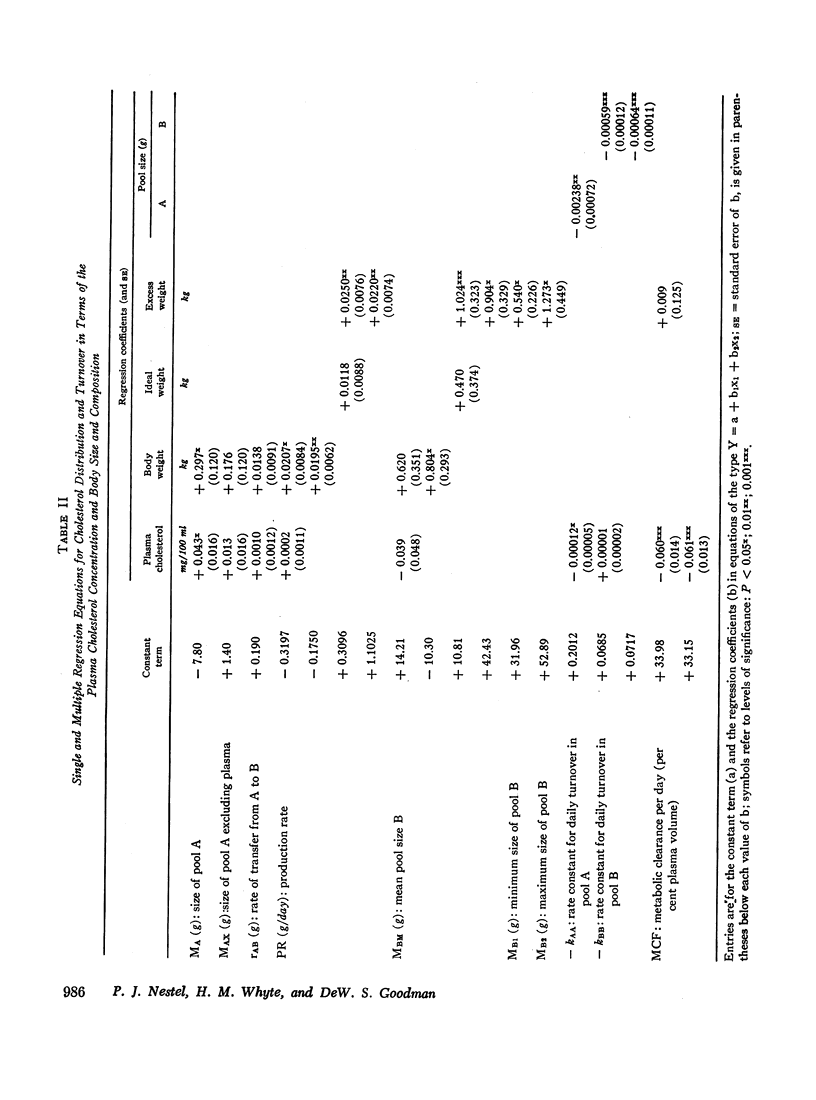
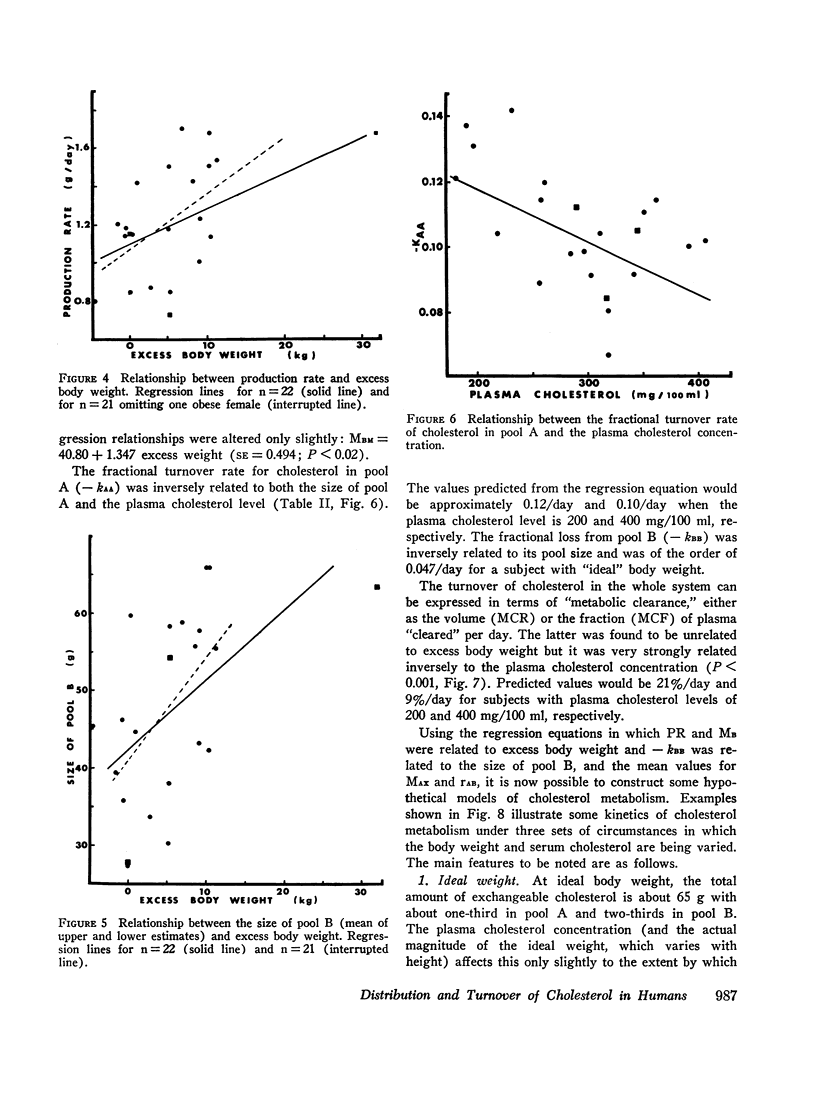
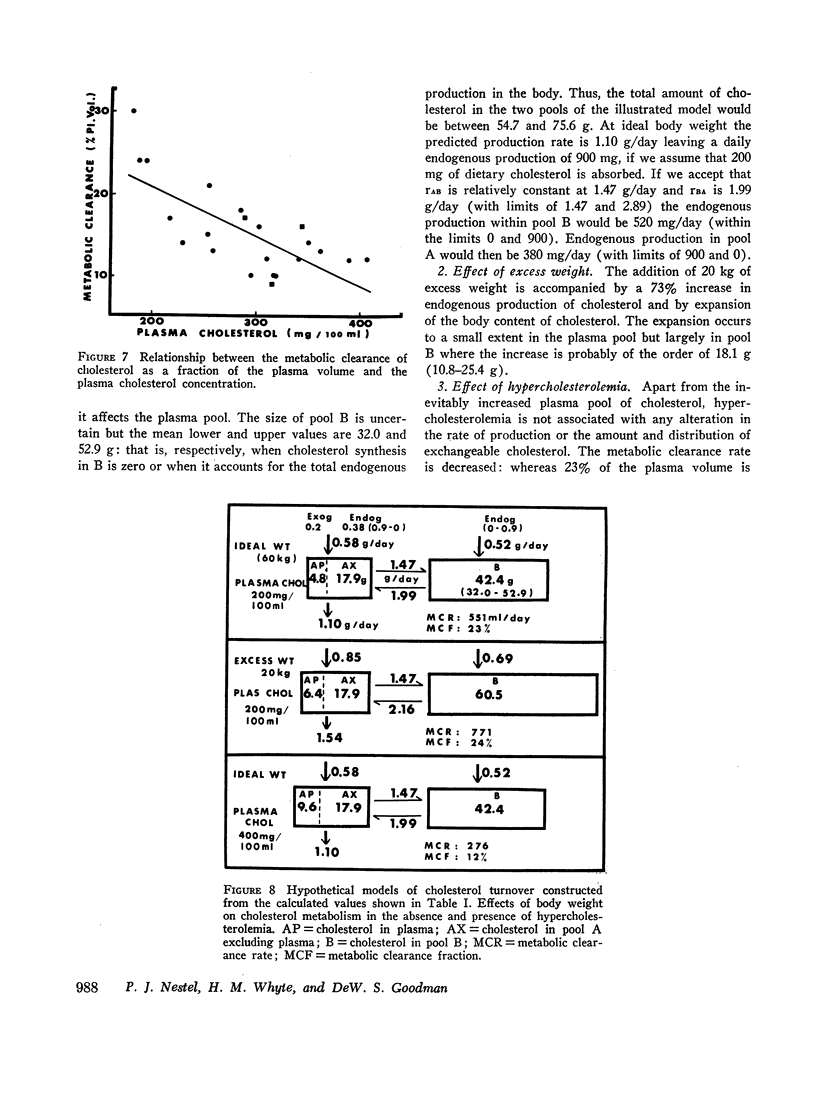
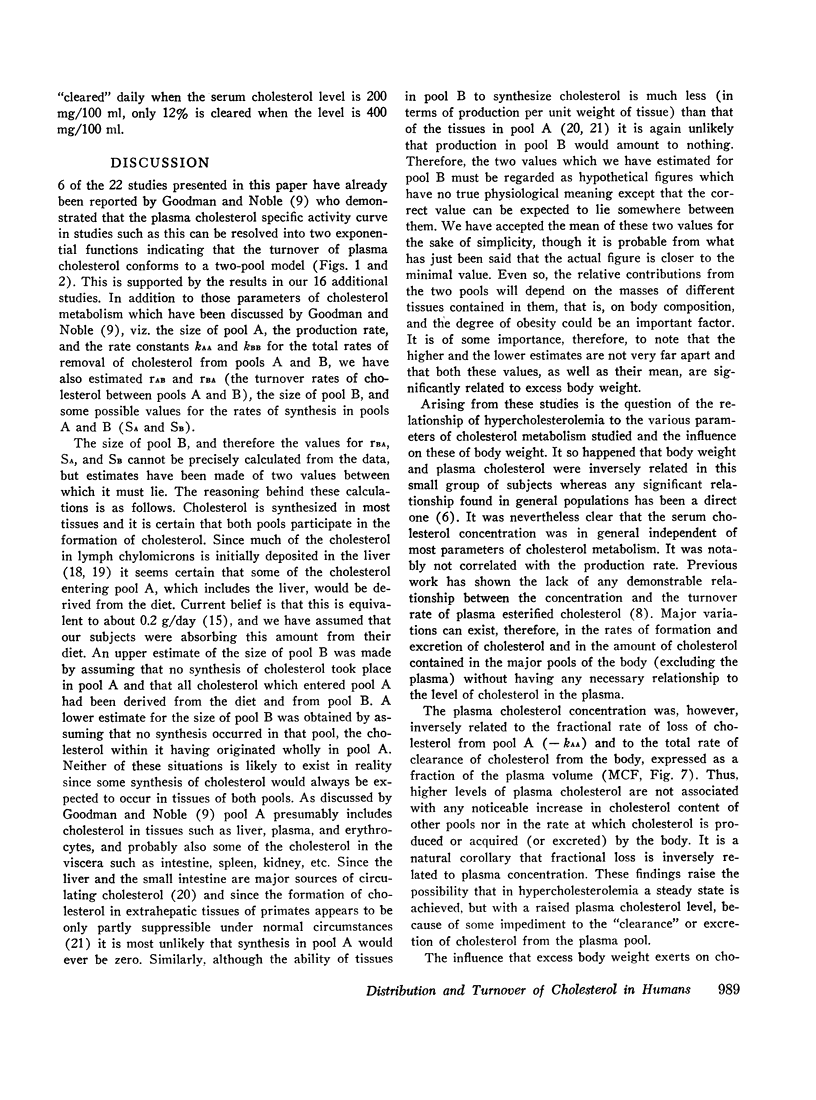
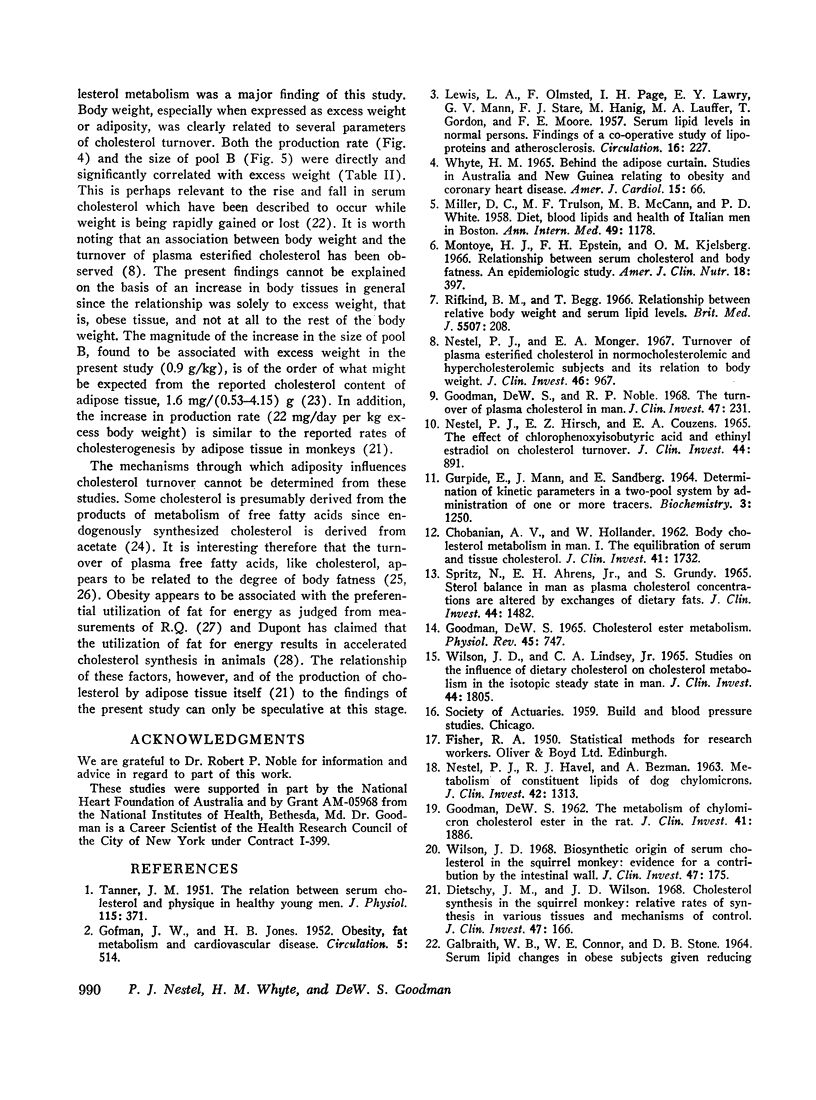
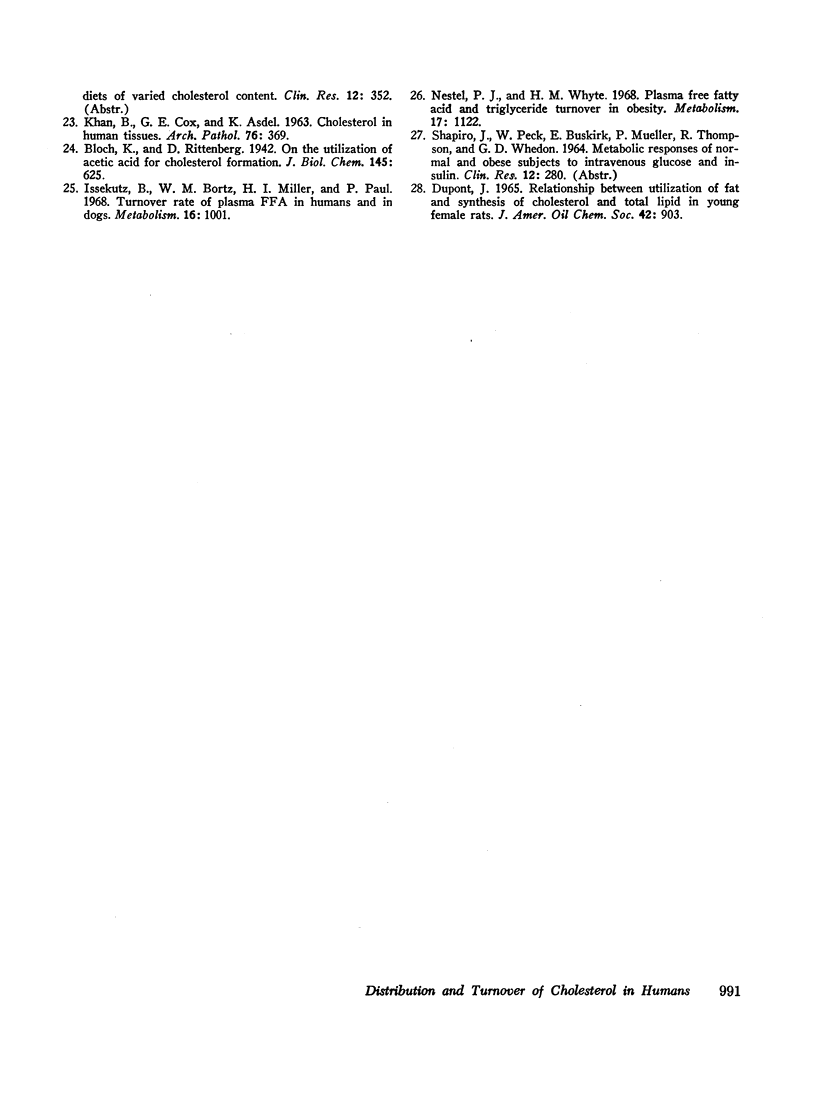
Selected References
These references are in PubMed. This may not be the complete list of references from this article.
- CHOBANIAN A. V., HOLLANDER W. Body cholesterol metabolism in man. I. The equilibration of serum and tissue cholesterol. J Clin Invest. 1962 Sep;41:1732–1737. doi: 10.1172/JCI104631. [DOI] [PMC free article] [PubMed] [Google Scholar]
- Dietschy J. M., Wilson J. D. Cholesterol synthesis in the squirrel monkey: relative rates of synthesis in various tissues and mechanisms of control. J Clin Invest. 1968 Jan;47(1):166–174. doi: 10.1172/JCI105706. [DOI] [PMC free article] [PubMed] [Google Scholar]
- GOFMAN J. W., JONES H. B. Obesity, fat metabolism and cardiovascular disease. Circulation. 1952 Apr;5(4):514–517. doi: 10.1161/01.cir.5.4.514. [DOI] [PubMed] [Google Scholar]
- GOODMAN D. S. The metabolism of chylomicron cholesterol ester in the rat. J Clin Invest. 1962 Oct;41:1886–1896. doi: 10.1172/JCI104645. [DOI] [PMC free article] [PubMed] [Google Scholar]
- GURPIDE E., MANN J., SANDBERG E. DETERMINATION OF KINETIC PARAMETERS INA TWO-POOL SYSTEM BY ADMINISTRATION OF ONE OR MORE TRACERS. Biochemistry. 1964 Sep;3:1250–1255. doi: 10.1021/bi00897a012. [DOI] [PubMed] [Google Scholar]
- Goodman D. S. Cholesterol ester metabolism. Physiol Rev. 1965 Oct;45(4):747–839. doi: 10.1152/physrev.1965.45.4.747. [DOI] [PubMed] [Google Scholar]
- Goodman D. S., Noble R. P. Turnover of plasma cholesterol in man. J Clin Invest. 1968 Feb;47(2):231–241. doi: 10.1172/JCI105719. [DOI] [PMC free article] [PubMed] [Google Scholar]
- Issekutz B., Jr, Bortz W. M., Miller H. I., Paul P. Turnover rate of plasma FFA in humans and in dogs. Metabolism. 1967 Nov;16(11):1001–1009. doi: 10.1016/0026-0495(67)90093-5. [DOI] [PubMed] [Google Scholar]
- KHAN B., COX G. E., ASDEL K. CHOLESTEROL IN HUMAN TISSUES. NEW CONSIDERATIONS. Arch Pathol. 1963 Oct;76:369–381. [PubMed] [Google Scholar]
- LEWIS L. A., OLMSTED F., PAGE I. H., LAWRY E. Y., MANN G. V., STARE F. J., HANIG M., LAUFFER M. A., GORDON T., MOORE F. E. Serum lipid levels in normal persons; findings of a cooperative study of lipoproteins and atherosclerosis. Circulation. 1957 Aug;16(2):227–245. doi: 10.1161/01.cir.16.2.227. [DOI] [PubMed] [Google Scholar]
- MILLER D. C., TRULSON M. F., McCANN M. B., WHITE P. D., STARE F. J. Diet, blood lipids and health of Italian men in Boston. Ann Intern Med. 1958 Nov;49(5):1178–1200. doi: 10.7326/0003-4819-49-5-1178. [DOI] [PubMed] [Google Scholar]
- Montoye H. J., Epstein F. H., Kjelsberg M. O. Relationship between serum cholesterol and body fatness. An epidemiologic study. Am J Clin Nutr. 1966 Jun;18(6):397–406. doi: 10.1093/ajcn/18.6.397. [DOI] [PubMed] [Google Scholar]
- NESTEL P. J., HAVEL R. J., BEZMAN A. METABOLISM OF CONSTITUENT LIPIDS OF DOG CHYLOMICRONS. J Clin Invest. 1963 Aug;42:1313–1321. doi: 10.1172/JCI104815. [DOI] [PMC free article] [PubMed] [Google Scholar]
- NESTEL P. J., HIRSCH E. Z., COUZENS E. A. THE EFFECT OF CHLOROPHENOXYISOBUTYRIC ACID AND ETHINYL ESTRADIOL ON CHOLESTEROL TURNOVER. J Clin Invest. 1965 Jun;44:891–896. doi: 10.1172/JCI105205. [DOI] [PMC free article] [PubMed] [Google Scholar]
- Nestel P. J., Monger E. A. Turnover of plasma esterified cholesterol in normocholesterolemic and hypercholesterolemic subjects and its relation to body build. J Clin Invest. 1967 Jun;46(6):967–974. doi: 10.1172/JCI105603. [DOI] [PMC free article] [PubMed] [Google Scholar]
- Nestel P. J., Whyte H. M. Plasma free fatty acid and triglyceride turnover in obesity. Metabolism. 1968 Dec;17(12):1122–1128. doi: 10.1016/0026-0495(68)90092-9. [DOI] [PubMed] [Google Scholar]
- Rifkind B. M., Begg T. Relationship between relative body weight and serum lipid levels. Br Med J. 1966 Jul 23;2(5507):208–210. doi: 10.1136/bmj.2.5507.208. [DOI] [PMC free article] [PubMed] [Google Scholar]
- SPRITZ N., AHRENS E. H., Jr, GRUNDY S. STEROL BALANCE IN MAN AS PLASMA CHOLESTEROL CONCENTRATIONS ARE ALTERED BY EXCHANGES OF DIETARY FATS. J Clin Invest. 1965 Sep;44:1482–1493. doi: 10.1172/JCI105255. [DOI] [PMC free article] [PubMed] [Google Scholar]
- TANNER J. M. The relation between serum cholesterol and physique in healthy young men. J Physiol. 1951 Dec 28;115(4):371–390. doi: 10.1113/jphysiol.1951.sp004676. [DOI] [PMC free article] [PubMed] [Google Scholar]
- WHYTE H. M. BEHIND THE ADIPOSE CURTAIN. STUDIES IN AUSTRALIA AND NEW GUINEA RELATING TO OBESITY AND CORONARY HEART DISEASE. Am J Cardiol. 1965 Jan;15:66–80. doi: 10.1016/0002-9149(65)90605-3. [DOI] [PubMed] [Google Scholar]
- Wilson J. D. Biosynthetic origin of serum cholesterol in the squirrel monkey: evidence for a contribution by the intestinal wall. J Clin Invest. 1968 Jan;47(1):175–187. doi: 10.1172/JCI105707. [DOI] [PMC free article] [PubMed] [Google Scholar]
- Wilson J. D., Lindsey C. A., Jr Studies on the influence of dietary cholesterol on cholesterol metabolism in the isotopic steady state in man. J Clin Invest. 1965 Nov;44(11):1805–1814. doi: 10.1172/JCI105288. [DOI] [PMC free article] [PubMed] [Google Scholar]


